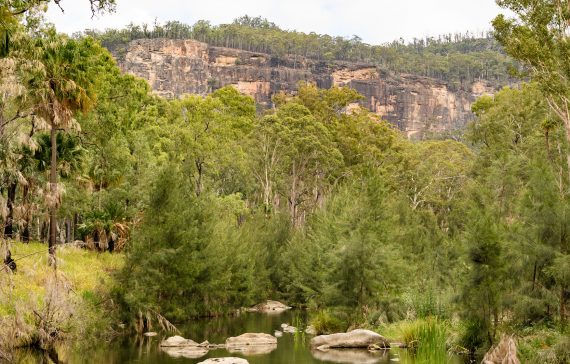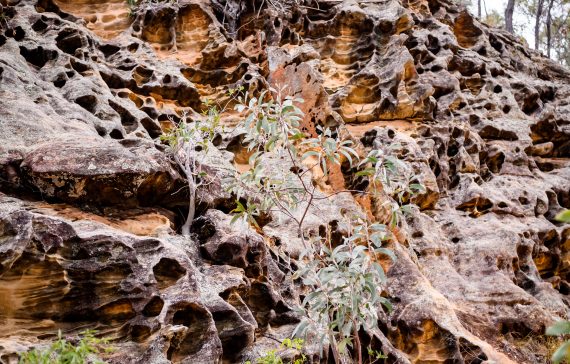We acknowledge the Traditional Owners of the land on which the Queensland Art Gallery | Gallery of Modern Art stands and recognise the creative contribution First Australians make to the art and culture of this country.
Environment
The Carnarvon Ranges is a rich and varied landscape, making it home to a wide variety of native flora and fauna.

Geography
The Carnarvon Ranges, located to the north of Roma, form a plateau section of the Great Diving Ranges in central Queensland. Towering sandstone cliffs and deep gorges define the landscape. The largest of these gorges, Carnarvon Gorge, is a 30-kilometre long valley through which runs Carnarvon Creek.
In 1932, the Royal Geographical Society of Queensland successfully lobbied to have Carnarvon Gorge declared a National Park. The Carnarvon National Park now covers an area close to 300,000 hectares.
Carnarvon Station lies in a valley adjacent to Carnarvon National Park. Once a 60,000 hectare cattle station, it is now a reserve, managed by Bush Heritage Australia.

Balbara yamba (Home of the Rivers)
For artist D Harding and their Uncle Milton Lawton, the Bidjara, Garingbal and Ghungalu languages are in a stage of revitalisation. Harding has applied their own knowledge of Bidjara language to form the term Balbara yamba, which means ‘Home of the Rivers’, to describe Canarvon Gorge. Harding also states that Elders in the region use gamu wangera (‘one water’) which refers to the place where ‘a number of waterways flow into the Fitzroy River at Rockhampton. So, they say gamu wangera for ‘one water’ for the whole region.’
The Department of Environment and Science refers to the Consuelo Tableland in the Carnarvon Ranges as the ‘Roof of Queensland’ or the ‘Home of the Rivers’ on the basis that it is the source of five major river systems: the Dawson, Maranoa, Warrego, Nogoa and Comet Rivers. Carnarvon Creek runs through the valleys of the Gorge, into the Comet and Dawson Rivers and through to the Fitzroy River which goes out to sea near Rockhampton. The Maranoa River flows into the Murray-Darling catchment and the Great Artesian Basin.

Sandstone
The Carnavon Ranges is part of the Central Queensland sandstone belt in the Central Highlands. Sheltered areas of sandstone in the Carnarvon Gorge display ancient rock art. These stencils, paintings and engravings are only as stable as the environment and the environmental protections in place at the site.
Despite a history of damage caused by pastoral activity, the sandstone formations of the Carnarvon Ranges have been a secure haven for a complex and distinct biodiversity. The mix of basalt and sandy soils overland and within the Gorge itself, along with a community of woodlands and grasslands in the surrounding flats have been a save haven for endangered species in the largely arid landscape of Central Queensland.

Bush Heritage
Watch this video produced by Bush Heritage Australia to learn about how their organisation is managing Carnarvon Station through the combined efforts of traditional custodians, scientists and conservationists.
Explore one of 15 biodiversity hotspots in Australia by researching Queensland and Australian Government protections in place across the fragmented Brigalow Belt Bioregion which includes the Carnarvon Ranges.
Make annotated sketches as you research the flora and fauna of the region.

Flora
The Ranges’ endemic plant life is not only a vital remaining stronghold for the conservation of endangered ecosystems, it is also a mesmerising canvas for studying landscape.
The brigalow (Acacia harpophylla) was once the dominant tree throughout the greater expanse of the bioregion. It produces a viscous gum that can be used as a gum arabic. The 1960s saw mass clearing of brigalows; the ‘“perfect storm” of mechanised land clearing, favourable government policies, scientific research into brigalow control, and a push for agricultural development’ resulted in extreme rates of clearing, at times equal to that in tropical rainforest regions such as the Amazon and Southeast Asia.
Livistona nitida is so abundant in the area that it has become known locally as the Carnarvon fan palm or Carnarvon Gorge cabbage palm. The threatened native thistle (Stemmacantha australis) lives within this expanse of Queensland bluegrass (Dichanthium sericeum).
In total, 1251 plants and 55 fungi make up the Carnarvon National Park ecosystem. 27 of the plants are rare or threatened species.

Fauna
The Carnarvon National Park is an oasis amongst the typically arid habitats of Central Queensland. The Park is home to 503 animal species, including:
- 72 mammals – 6 of which are rare or threatened species
- 246 birds – 4 of which are rare or threatened species
- 71 reptiles – 3 of which are rare or threatened species
- 17 amphibians – 1 of which is a rare or threatened species
- 9 ray-finned fishes
- 88 insects – 1 of which is a rare or threatened species
Consider also the impact past government policies encouraging the culling of native species have had on the fauna in the Carnarvon Ranges.
Additional Resources
Mount Moffatt — Nature Culture and History, Department of Environment and Science, Queensland, viewed June 2020 URL: https://parks.des.qld.gov.au/parks/carnarvon-mount-moffat/about/culture
Carnarvon National Park — facts and maps, WetlandInfo, Department of Environment and Science, Queensland, viewed June 2020, URL: https://wetlandinfo.des.qld.gov.au/wetlands/facts-maps/national-park-carnarvon/
Seabrook, L., McAlpine, C., Maron, M. 2016. The Conversation, EcoCheck: can the Brigalow Belt bounce back? viewed June 2020, URL: https://theconversation.com/ecocheck-can-the-brigalow-belt-bounce-back-57128